Multi-center clinical evaluation of the Access AMH assay to determine AMH levels in reproductive age women during normal menstrual cycles
- PMID: 29536384
- PMCID: PMC5984885
- DOI: 10.1007/s10815-018-1141-5
Multi-center clinical evaluation of the Access AMH assay to determine AMH levels in reproductive age women during normal menstrual cycles
Abstract
Background: AMH is widely used for assessing ovarian reserve, and it is particularly convenient, because it is thought to have minimal variability throughout the menstrual cycle. However, studies assessing the stability of AMH over the menstrual cycle have been conflicting.
Purpose: The purpose of this study is to determine whether AMH levels vary across the normal menstrual cycle.
Design: A multi-center, prospective cohort study conducted at three US centers.
Methods: Fifty females with regular menstrual cycles aged 18-45 underwent serial venipuncture every 3-5 days starting in the early follicular phase and lasting up to 10 collections. AMH was tested using the Access 2 immunoassay system.
Results: Age-adjusted mixed-effect models utilizing data from 384 samples from 50 subjects demonstrated a within subject standard deviation of 0.81 (95% CI 0.75-0.88) with a coefficient of variation of 23.8% across the menstrual cycle and between subject standard deviation of 2.56 (95% CI 2.13-3.21) with a coefficient of variation of 75.1%. Intra-class correlation (ICC) of AMH across the menstrual cycle was 0.91.
Conclusion: Overall, AMH levels, using the automated Access AMH assay, appear to be relatively stable across the menstrual cycle. Fluctuations, if any, appear to be small, and therefore, clinicians may advise patients to have AMH levels drawn at any time in the cycle.
Keywords: AMH; Access AMH; Anti-Mullerian hormone; Endocrinology; Intra-cycle variability; Menstrual cycle; Ovarian reserve.
Conflict of interest statement
IRB approval was obtained at each site, and informed consent was obtained from all participants prior to enrollment.
Figures
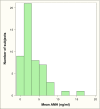
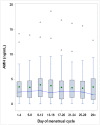
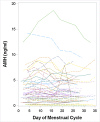
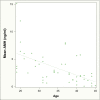
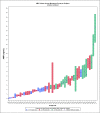
Similar articles
-
Levels of antimüllerian hormone in serum during the normal menstrual cycle.Fertil Steril. 2016 Jan;105(1):208-13.e1. doi: 10.1016/j.fertnstert.2015.09.033. Epub 2015 Oct 23. Fertil Steril. 2016. PMID: 26477497
-
Relationship between anti-Müllerian hormone and antral follicle count across the menstrual cycle using the Beckman Coulter Access assay in comparison with Gen II manual assay.Clin Chem Lab Med. 2017 Jun 27;55(7):1025-1033. doi: 10.1515/cclm-2016-0609. Clin Chem Lab Med. 2017. PMID: 27987358
-
Comparison of inter- and intra-cycle variability of anti-Mullerian hormone and antral follicle counts.Hum Reprod. 2010 Jan;25(1):221-7. doi: 10.1093/humrep/dep366. Epub 2009 Oct 19. Hum Reprod. 2010. PMID: 19840990
-
Antimüllerian hormone levels and numbers and sizes of antral follicles in regularly menstruating women of reproductive age referenced to true ovulation day.Fertil Steril. 2015 Dec;104(6):1535-43.e1-4. doi: 10.1016/j.fertnstert.2015.08.027. Epub 2015 Sep 15. Fertil Steril. 2015. PMID: 26384163
-
The utility of measuring anti-Müllerian hormone in predicting menopause.Climacteric. 2015;18(6):777-89. doi: 10.3109/13697137.2015.1036853. Epub 2015 Sep 16. Climacteric. 2015. PMID: 25845388 Review.
Cited by
-
Autologous Platelet-Rich Plasma Treatment Enables Pregnancy for a Woman in Premature Menopause.J Clin Med. 2018 Dec 20;8(1):1. doi: 10.3390/jcm8010001. J Clin Med. 2018. PMID: 30577435 Free PMC article.
-
Can Anti-Müllerian Hormone Be a Reliable Biomarker for Assessing Ovarian Function in Women Postchemotherapy?Cancer Manag Res. 2020 Sep 8;12:8171-8181. doi: 10.2147/CMAR.S269249. eCollection 2020. Cancer Manag Res. 2020. PMID: 32982414 Free PMC article.
-
Serum anti-Mullerian hormone levels in Turkish girls aged 18 and younger for ovarian reserve determination.J Turk Ger Gynecol Assoc. 2024 Aug 29;25(3):138-143. doi: 10.4274/jtgga.galenos.2024.2023-8-5. Epub 2024 May 22. J Turk Ger Gynecol Assoc. 2024. PMID: 38775713 Free PMC article.
-
Therapeutic options for premature ovarian insufficiency: an updated review.Reprod Biol Endocrinol. 2022 Feb 4;20(1):28. doi: 10.1186/s12958-022-00892-8. Reprod Biol Endocrinol. 2022. PMID: 35120535 Free PMC article. Review.
-
Clinical Application of AMH Measurement in Assisted Reproduction.Front Endocrinol (Lausanne). 2020 Dec 9;11:606744. doi: 10.3389/fendo.2020.606744. eCollection 2020. Front Endocrinol (Lausanne). 2020. PMID: 33362720 Free PMC article. Review.
References
-
- Robertson DM, Kumar A, Kalra B, Shah S, Pruysers E, Vanden Brink H, et al. Detection of serum antimüllerian hormone in women approaching menopause using sensitive antimüllerian hormone enzyme-linked immunosorbent assays. Menopause. 2014;21(12):1277–1286. doi: 10.1097/GME.0000000000000244. - DOI - PubMed
Publication types
MeSH terms
Substances
LinkOut - more resources
Full Text Sources
Other Literature Sources

